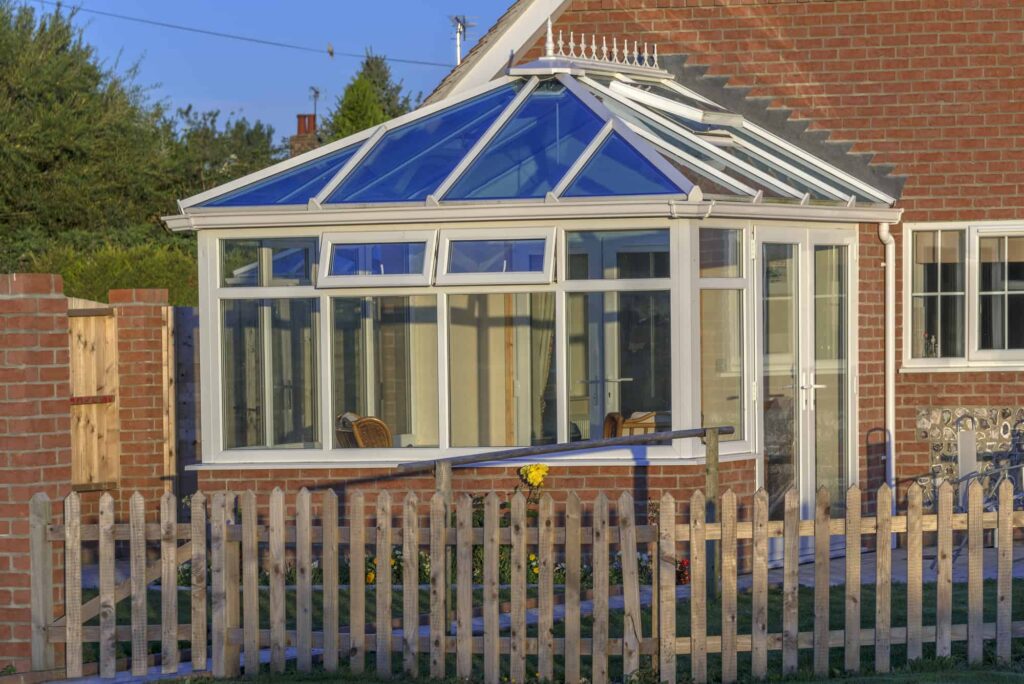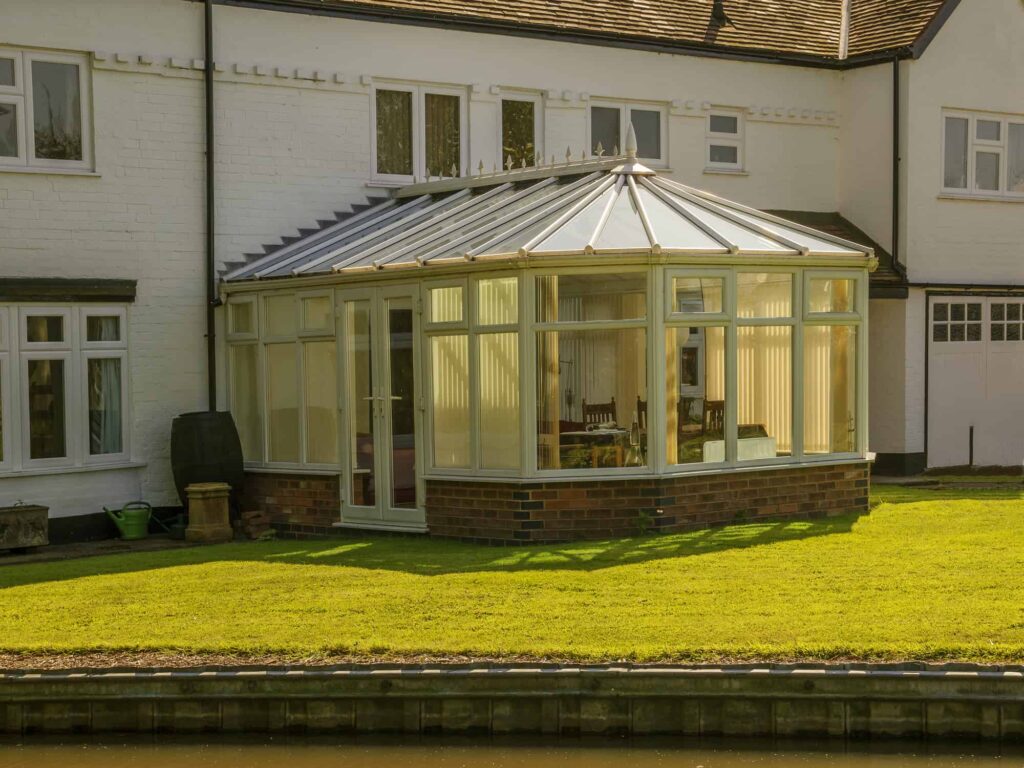
Get up to 4 quotes from our selected suppliers by filling in only 1 form

Save money by comparing quotes and choosing the most competitive offer

Our service is 100% free and with no obligation
- GreenMatch
- Conservatory
- Conservatories for Bungalows
Conservatories for Bungalows: Styles & Costs Compared
In the last couple of years people have spend more time that ever in their own homes. This has led to many people wanting to create more living space. With extensions often being complex, expensive and needing planning permission or building regulations, conservatories have become increasingly popular. With all of that time indoors, people have looked for ways of being closer to nature and bringing the outside in – and a conservatory covers all of those things.
However, when it comes to conservatories for bungalows, people are often a little unsure. Is it possible to add a conservatory onto a bungalow? How does it work in terms of style? And, do you need specialist installers for conservatories for bungalows? If you’ve asked these sorts of questions or want to know more about conservatories for bungalows, this article will hopefully answer any queries you have.

How does a bungalow conservatory work?
Lots of homeowners see conservatories that adjoin the house wall high up with a steeply pitched roof. With this vision, many people believe that a bungalow conservatory won’t be possible. However, this isn’t the case.
With conservatories for bungalows, you have two main choices:
- You can add a conservatory onto the bungalow gable end. This usually means that there is a high enough wall similar to any other home. With this conservatory style, your conservatory roof would be at the full height of your home.
- If the area where the conservatory will be isn’t a gable end and the roof is just above the window, this isn’t an issue. It is still possible to have bungalow conservatories added. In this situation, you need something called a box gutter. The roof of the conservatory will slope downwards and backwards towards the guttering of the bungalow. The box gutter simply joins both together.
Conservatories for bungalows style options
There are lots of options when it comes to choosing a conservatory style for your bungalow. Let’s take a look at some popular bungalow conservatories.
Gable bungalow conservatories
This type of conservatory is distinguishable by its flat-fronted open high ceiling like looks like a house gable end. Gable end conservatories are great for creating space and height towards the front thanks to its open, high aspect. The back of a gable end conservatory will slope downwards towards the gutter.
Georgian bungalow conservatories
A Georgian conservatory is one of the best conservatory styles for a bungalow. This is a popular conservatory style for all types of home so it doesn’t look out of place on a bungalow and it doesn’t need anything to be compromised or specially adapted for a bungalow.
Just like gable end conservatories, Georgian conservatories have optimum floor space thanks to their angular nature. Georgian bungalow conservatories can have furniture placed anywhere and there isn’t wasted space. These are also considered to be a more modern style of conservatory that would suit bungalows and new build properties.

Victorian bungalow conservatories
Victorian conservatories are also a good choice for bungalows. Their curved elevation and the front (typically with three, four or five facets) makes them distinguishable from other conservatory styles. Victorian conservatories are attached to the bungalow with a box gutter. This means that the conservatory roof that is nearest to main property would slope downwards and backwards.
Lean to conservatory for a bungalow
With its sloped roof, a lean to conservatory is a perfect conservatory style for a bungalow as it will not be taller than the adjoining properly and will look aesthetically pleasing. These fit snugly onto your existing property and don’t have planning requirements. This type of conservatory is great for height restricted properties where there isn’t a lot of space. Lean to conservatories to can add extra living space while maintaining a smaller footprint.
Hipped back Edwardian bungalow conservatory
This style of bungalow conservatory makes the conservatory look more separate and stand-alone. This means that the roof height issue isn’t a problem. From a visual perspective, therefore, these work well with bungalows and look more like an extension. A hipped back conservatory is usually considered to be a permitted development and won’t require planning permission.
Edwardian conservatories are stylish and sleek. These are designed for liveability and lack the more ornate features of a Victorian conservatory.
Orangery conservatory
This type of conservatory is the nearest thing to having an extension without having an extension. Many bungalow owners choose an orangery as a focal point in their property and these are becoming more and more popular.
Traditional conservatories tend to have windows around the side while an orangery has a glass roof that is surrounded by solid walls. You will often still have windows but the brick design means this style of conservatory has a completely different look.
Orangeries are extremely versatile as this conservatory design doesn’t loose much heat during the winder months. They’re an ideal solution for creating more space on smaller properties.
In terms of restrictions, orangeries are usually allowed as a permitted development so you likely won’t need to seek planning permission. Local companies will talk you through the finer details of its construction.
Which style should you choose?
Victorian, Georgian, lean to, Edwardian and gables are all suitable styles of conservatory for a bungalow. If you build your conservatory on the gable end of your property, it won’t affect the style you can choose. Bungalows are often smaller in terms of square footage and footprint than other types of home and so adding a conservatory is a great value of adding space and value. The style you choose is really down to personal taste.
Bungalow conservatory customisation
All types of bungalow conservatory can be customised. Here are some of the choices you can make:
- dwarf wall or full glass
- glass, solid roof, or polycarbonate bungalow roof
- a choice of door style – bi fold doors, patio doors, French doors, or panelled doors
- a choice of glass type
- a choice of colours including white, oak, grey, and rosewood – plus many others
Dwarf wall or full glass
Deciding whether to add a dwarf wall conservatory or a full glass one is down to personal choice. Dwarf wall bungalow conservatories as the name suggests, have a small wall of around 60 cm in height before the glass begins. This is good for adding strength to a build and a little more privacy. If you’re choosing a heavy glass or solid conservatory roof then opting for dwarf walls is a good idea. Dwarf walls also mean the conservatory has an internal windowsill which many prefer.
Glass or polycarbonate roofing
Most people choose glass or polycarbonate for their conservatory roof or lean to conservatory, but you can choose a solid tiled roof. A glass roof is often the preferred option as glass retains heat better. Glass is also stronger and can withstand more harsh weather events than polycarbonate. The main reason many people choose polycarbonate roofing is down to the cost.
Door style
The door style is down to personal choice. If floor space is an issue, sliding doors or doors that open outwards create extra space in the conservatory.
Conservatory glass type
There is a lot of choice available when it comes to choosing glass for your dream conservatory windows. Here are some of the options:
- single glazing
- double glazing
- triple glazing
- laminated glass
- toughened glass
- solar control glass
- argon filled glass
- xenon filled glass
Conservatory colour and material choice
Though many conservatories are white, a new conservatory doesn’t have to be. These days you can choose lots of different conservatory colours including black, grey, white, green, brown, oak and rosewood to name a few.
In terms of materials, uPVC, aluminium and timber are common choices. uPVC conservatories tend to be the most cost effective.
Benefits of having a bungalow conservatory
Bungalow conservatories have many benefits including:
- Enhancing the size and value of your existing property – a good conservatory design that is well built will add as much as 5% to the value of your home
- Creating maximum living space and making the most of your garden
- Creating a new natural light-filled room for extra living space – you can never have too much space in a home!
- year round garden visibility
Should you choose a conservatory or an extension?
Since bungalows are one one floor, they tend to have bigger gardens. This means there is often more choice for extensions and conservatories. Many people struggle to decide whether to go for a conservatory or an extension and there are pros and cons to each.
Benefits of a conservatory
- Excellent for natural light
- Good for awkward spaces
- Create more room with less expense
- Cheaper
- You likely won’t need planning permission
Benefits of an extension
- More options
- Less noise on rainy days
- More energy efficient
- The inside temperature will be more consistent
- More privacy
Conservatory prices
Of course, conservatories for bungalows come in a wide range of prices due to their bespoke nature. Different conservatory designs have different costs. It’s not just about materials, installing conservatories is a skill and installation will usually be included in the quote price.
However, to give you an idea of cost, here are some examples of prices that you might pay:
- Lean to conservatories with a dwarf wall and approximately 3×3 metres – £5000
- Edwardian conservatory with dwarf wall and approximately 3×3 metres – £5800
- Hipped back Edwardian conservatory with dwarf wall and approximately 3×3 metres – £6500
- Victorian conservatory with dwarf wall and approximately 3×3 metres – £5800
- Gable front conservatory with dwarf wall and approximately 3×3 metres – £6400
- P-Shape conservatory with dwarf wall and approximately 3.5×3 metres – £6600
- T-Shape conservatory with dwarf wall and approximately 4×3 metres – £7400
- Orangery with dwarf wall and approximately 3×3 metres – £9000
Making your choice
As you’ve read, there are lots of conservatory designs suitable for bungalows. Whether you’re looking to create a play room, reading room, dining room or just create more space and more light in your original house, a conservatory is a cost effective way of doing this.
Before you take the leap, consider all of your options. Do you want a hipped roof or a lean to? Do you want the glass to go to ground level? Is a symmetrical shape important to you? Which room will provide access to the conservatory? What about the roof? Your choice of conservatory depends on many different things. Owners of bungalows tend to believe that they don’t have much choice when it comes to conservatories, but there are so many options out there – even ones that are suitable for small gardens or height restrictions.
If budget isn’t an issue, an orangery is a very stylish addition to a single storey home and create that much needed extra space while being a focal point in the home. Nowadays, conservatories are much more thermally efficient than they used to be.
Ultimately, bungalow owners need to decide what is best for their needs and budget. After doing this, it becomes a lot easier to make a final decision.
 We strive to connect our customers with the right product and supplier. Would you like to be part of GreenMatch?
We strive to connect our customers with the right product and supplier. Would you like to be part of GreenMatch? 